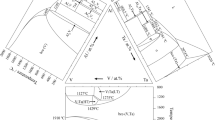Abstract
A BET thermodynamic model and its recently modified version were applied to predict the phase diagrams of the systems NH4NO3–LiNO3–H2O and NaNO3–LiNO3–Mg(NO3)2–H2O, in which two eutectic points were found with melting point at temperatures between 15 °C and 25 °C. Simple experiments were designed to measure the exothermal and endothermal behavior of the predicted phase change materials. The experimental results showed that the theoretically predicted materials possess excellent exothermal and endothermal behavior at room temperatures. Besides, the fusion and solidification heats of the predicted phase change materials were measured.














Similar content being viewed by others
References
Hasnain SM. Review on sustainable thermal energy storage technologies part I: heat storage materials and techniques. Energy Convers Manage. 1998;39:1127–38.
Voigt W, Zeng D. Solid-liquid equilibria in mixtures of molten salt hyrates for the design of heat storage materials. Pure Appl Chem. 2002;74:1909–20.
Nagano K, Mochida T, Takeda S, Domanski R, Rebow M. Thermal characteristics of manganese (II) nitrate hexahydrate as a phase change material for cooling system. Appl Therm Eng. 2003;23:229–41.
Nagano K, Ogawa K, Mochida T, Hayashi K, Ogoshi H. Thermal characteristics of magnesium nitrate hexahydrate and magnesium chloride hexahydrate mixture as a phase change material for effective utilization of urban waste heat. Appl Therm Eng. 2004;24:209–20.
Nagano K, Ogawa K, Mochida T, Hayashi K, Ogoshi H. Performance of heat charge/discharge of magnesium nitrate hexahydrate and magnesium chloride hexahydrate mixture to a single vertical tube for a latent heat storage system. Appl Therm Eng. 2004;24:221–32.
Stokes RH, Robinson RA. Ionic hydration and activity in electrolyte solutions. J Amer Chem Soc. 1948;70:1870–8.
Ally MR, Braunstein J. Statistical mechanics of multilayer adsorption: electrolyte and water activities in concentrated solutions. J Chem Thermodyn. 1998;30:49–58.
Voigt W. Calculation of salt activities in molten salt hydrates applying the modified BET equation (I): binary system. Monatsh Chem. 1993;124:839–48.
Zeng D, Voigt W. Phase diagram calculation of molten hydrates using the modified BET equation. Calphad. 2003;27:243–51.
Zeng D, Liu H, Chen Q. Simulation and prediction of solubility phase diagram for the separation of MgCl2 from LiCl brine using HCl as a salting-out agent. Hydrometallurgy. 2007;89:21–31.
Zeng D, Ming J, Voigt W. Thermodynamic study of the system LiCl–LiNO3–H2O. J Chem Thermodyn. 2008;40:232–9.
Zeng D, Xu W, Voigt W, Yin X. Thermodynamic study of the system LiCl–CaCl2–H2O. J Chem Thermodyn. 2008;41:1157–65.
Rains WO, Cownce RM. Liquidus curves of NH4NO3(aq) calculated from the modified adsorption isotherm model for aqueous electrolytes. Sep Sci Technol. 2006;41:2629–34.
Ally MR. Liquidus curve of NaNO3(aq) calculated from the modified adsorption isotherm model for aqueous electrolytes. Monatsh Chem. 2000;131:341–4.
Linke WF, Seidell A. Solubilities of inorganic and metal organic compounds. 4th ed. Washington: American Chemical Society; 1965. p. II423. (p. II511, p. II709).
Campbell AN. The system: LiNO3–NH4NO3 and LiNO3–NH4NO3–H2O. J Amer Chem Soc. 1942;64:2680–4.
Campbell AN, Bailey RA. The system lithium nitrate–ethanol–water and its component binary systems. Can J Chem. 1958;36:518–36.
Andronova NP. Solium nitrate–lithium nitrate–water system at 50 deg. Uch Zap Yarosl Gos Ped Inst. 1972;103:50–1.
Chernykh LV, Bulgakova TN, Skripkin MYu. Thermodynamic study of MgX2–LiX–H2O system (X = Br, NO3, ClO4) at 0 and 50 °C. Zh Prikl Khim. 1998;71:1425–30.
Zbranek V, Eysseltova J. Study of the ternary systems M(II) (NO3)2–LiNO3–H2O (M(II) = Mg, Ca, Sr, Ba) at 25 °C. Monatsh Chem. 2001;132:1463–75.
Acknowledgements
This work is financially supported by the Ministry of Science and Technology, PR China, under contract number 2006AA05Z212 and 2006CB708640.
Author information
Authors and Affiliations
Corresponding author
Rights and permissions
About this article
Cite this article
Li, B., Zeng, D., Yin, X. et al. Theoretical prediction and experimental determination of room-temperature phase change materials using hydrated salts as agents. J Therm Anal Calorim 100, 685–693 (2010). https://doi.org/10.1007/s10973-009-0206-1
Received:
Revised:
Accepted:
Published:
Issue Date:
DOI: https://doi.org/10.1007/s10973-009-0206-1




